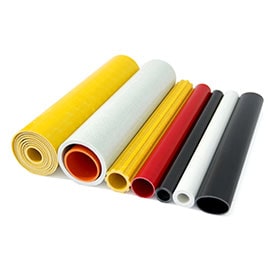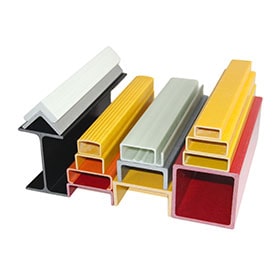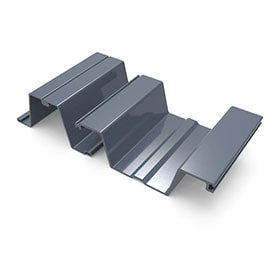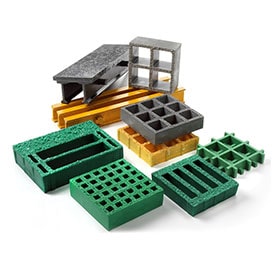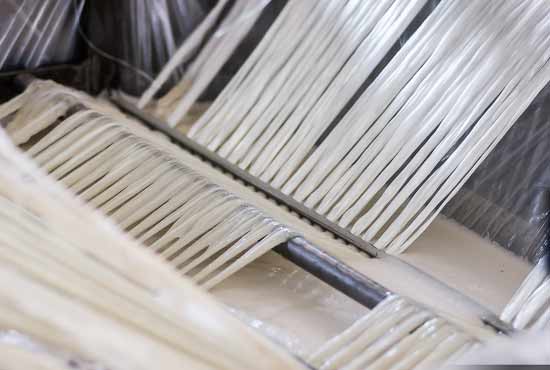
Fiber reinforced polymer (FRP) is a composite material made of a polymer matrix reinforced with fibers. The fibers are usually glass, carbon, or aramid, although other fibers such as paper, wood, or asbestos have been sometimes used. The polymer is usually an epoxy, vinylester, or polyester thermosetting plastic, and phenol formaldehyde resins are still in use.
FRP materials have many advantages over conventional materials, such as:
High strength-to-weight ratio: FRP materials are very strong and lightweight compared to metals or concrete. For example, carbon fiber reinforced polymer (CFRP) has a tensile strength of about 3,000 MPa, which is more than 10 times higher than that of steel.
High stiffness: FRP materials have high modulus of elasticity, which means they can resist deformation under load. For example, CFRP has a modulus of about 230 GPa, which is about five times higher than that of steel.
Corrosion resistance: FRP materials are resistant to chemical attack and environmental degradation, which makes them suitable for applications in harsh conditions. For example, FRP materials can withstand exposure to seawater, acids, alkalis, and salts.
Vibration resistance: FRP materials have high damping properties, which means they can absorb and dissipate energy from vibrations and shocks. This can reduce noise and improve comfort and safety.
High ultimate strain: FRP materials can undergo large deformations before failure, which gives them high toughness and ductility. For example, CFRP has an ultimate strain of about 1.5%, which is much higher than that of steel (0.2%) or concrete (0.01%). High fatigue resistance: FRP materials can withstand repeated loading and unloading without significant loss of strength or stiffness. This can extend the service life and reduce the maintenance costs of structures.
Low thermal conductivity: FRP materials have low thermal conductivity, which means they can provide good insulation and reduce heat loss or gain. This can improve the energy efficiency and fire safety of buildings.
However, FRP materials also have some disadvantages, such as:
High cost: FRP materials are generally more expensive than conventional materials, especially for high-performance fibers such as carbon or aramid. The cost of FRP materials depends on the type and quality of the fibers, the resin system, the manufacturing process, and the market demand.
Brittleness: FRP materials are prone to brittle fracture under sudden or impact loading, especially for fibers with high modulus and low elongation. The fracture behavior of FRP materials is also influenced by the fiber-matrix interface, the fiber orientation, the environmental conditions, and the presence of defects or damage.
Recycling challenges: FRP materials are difficult to recycle due to their complex structure and composition. The recycling methods for FRP materials include mechanical grinding, thermal decomposition, chemical dissolution, and biological degradation. However, these methods have limitations in terms of efficiency, quality, environmental impact, and economic feasibility.
Applications and extensions
FRP materials have been widely used in various fields of engineering and technology, such as aerospace, automotive, marine, civil infrastructure, sports equipment, biomedical devices, etc. Some examples of applications are:
Aerospace: FRP materials are used for structural components such as wings, fuselage, tail fins, landing gears, etc., as well as for non-structural components such as radomes, fairings, ducts, etc. FRP materials can reduce the weight and increase the performance and durability of aircrafts.
Automotive: FRP materials are used for body panels, bumpers, spoilers, hoods, doors, etc., as well as for interior components such as dashboards, seats, steering wheels, etc. FRP materials can improve the fuel efficiency, safety, and aesthetics of vehicles.
Marine: FRP materials are used for hulls, decks, masts, spars, rudders, etc., as well as for propellers, pumps, pipes, etc. FRP materials can enhance the seaworthiness, maneuverability, and corrosion resistance of ships and boats.
Civil infrastructure: FRP materials are used for bridges, buildings, tunnels, dams, pipes, tanks, etc., as well as for reinforcement bars, prestressing tendons, cables, etc. FRP materials can increase the strength, stiffness, and durability of concrete structures.
Sports equipment: FRP materials are used for golf clubs, tennis rackets, bicycles, skis, snowboards, hockey sticks, fishing rods, etc., as well as for helmets, shoes, gloves, etc. FRP materials can improve the performance, comfort, and safety of athletes.
Biomedical devices: FRP materials are used for artificial limbs, joints, bones, teeth, etc., as well as for implants, stents, sutures, etc. FRP materials can provide biocompatibility, biodegradability, and bioactivity for medical applications.
FRP materials have great potential for further development and innovation, as new types of fibers, resins, and manufacturing methods are being explored and optimized. Some possible extensions are:
Nanocomposites: Nanocomposites are composites that contain nanoscale fillers, such as carbon nanotubes, graphene, nanoclays, etc., in the polymer matrix. Nanocomposites can enhance the mechanical, thermal, electrical, optical, and magnetic properties of FRP materials.
Smart composites: Smart composites are composites that can sense and respond to external stimuli, such as temperature, pressure, strain, electric field, magnetic field, etc. Smart composites can provide self-healing, self-adaptive, self-monitoring, and self-regulating functions for FRP materials.
Hybrid composites: Hybrid composites are composites that combine different types of fibers or matrices in a single structure. Hybrid composites can optimize the performance and cost of FRP materials by exploiting the synergistic effects of the constituents.
 +86 15303735673
+86 15303735673 Jessica@frpzs.com
Jessica@frpzs.com
 Technical Data
Technical Data


